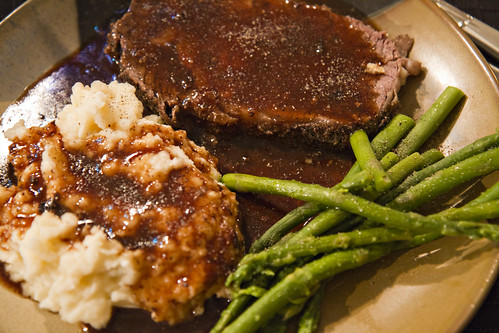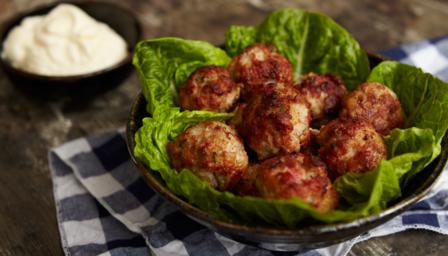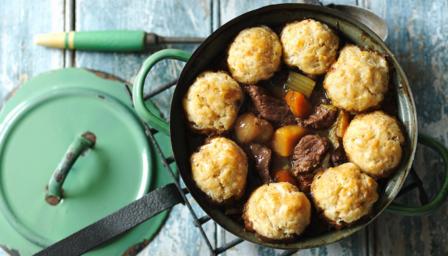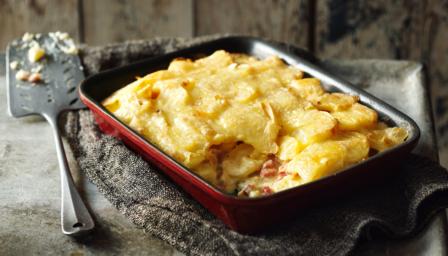Standing Rib Roast au Jus

December is Roast Post Month at Yankee Cook. Hooray! [noisemaker sound] Each Thursday until New Years we’ll be posting a new holiday roast for your holiday inspiration. This year’s Roast Post theme is Party of Four - each roast recipe is written to accommodate four people as opposed to the usual eight or ten, because not every holiday party has dozens of people in attendance. We’re kicking off Roast Post Month with Standing Rib Roast au Jus.
Standing rib roast is the same cut of meat as prime rib before it’s been cut into steaks. A full standing rib roast rack has seven ribs, and can weigh up to 16 lbs and yield as many servings. A two rib roast normally weighs between 3.5 to 4.5 lbs. What’s nice about making a smaller standing rib roast is that while it’s large enough to carve at the table, it’s also small enough to sear in a pan after it roasts. Roasting at the relatively low temperature of 325 degrees gives you control over the doneness of the center and prevents the outer edges of the meat from overcooking. A quick pan-sear finishes the roast off for a crispy exterior. Another benefit to roasting small – it takes a lot less time to cook.
One thing that’s nice about standing rib roast is that it doesn’t require a roasting pan with a rack. The ribs act as a rack, so if you’re just starting out and you don’t have a roasting pan, make this and you can just use a baking dish. You could even use a brownie pan.
Carving tip: To make the roast easier to carve, remove the ribs first and tie them back on using butcher’s twine. This way the person carving will only need to make vertical slices for the steaks to come off. After dinner, save the bones to make beef stock.
Standing Rib Roast - serves 4
Special equipment: You will need a meat thermometer and butcher’s string.
3.5 – 4.5 lb standing rib roast
 1 – 2 T salt
1 – 2 T salt6 sprigs of sage
6 sprigs of thyme
2 t cumin
1 T olive oil
1 – 1.5 t salt
2 C beef stock
additional sage and thyme sprigs for garnish (optional)
Start off by severing the ribs from the rest of the meat. Place the roast in a cutting board with the rib side down, starting at cut side of the bone, run a knife horizontally along the bone to remove the roast from the bone. Set the ribs aside. Trim away any extra fat from the top of the roast. Generously salt the roast with one to two tablespoons of salt. Fit the roast over the ribs and use two pieces of butcher’s string to tie the two parts back together just as they had been before the ribs were removed .
Place the roast on the counter in a large plate. Allow to sit for 1 hour at room temperature. This will take away the chill from the fridge in order to allow the meat to cook more evenly in the center.
Heat the oven to 325 degrees. Finely mince 1 tablespoon of each of the sage and the thyme (about 2 or 3 sprigs) Combine the herbs, cumin olive oil, and salt in a small bowl.
Remove the salt from the rib roast using paper towels. Pat dry.
Rub the herb mixture into the roast and place the roast in a large baking dish.
Insert the meat thermometer into the center of the roast so that it’s not touching a bone. Place the roast in the center of the oven and cook until the thermometer reads 135 degrees (about 1 3/4 to 2 hours) for medium rare or 150 for medium (about 2 – 2 1/4 hours).
Remove the roast from the oven and, keeping the thermometer in place, loosely tent the roast with foil. Allow the roast to rest for at least 20 minutes or up to an hour. The temperature will continue to climb another 10 or 11 degrees.

After the roast has rested, take about a tablespoon of the rendered fat from the baking dish and heat to a shimmer over medium high heat in a large frying pan.
Sear all sides of the roast in the frying pan using tongs – at least 30 seconds per side or until a crispy, brown crust forms. Set the roast on a serving platter or carving board with channels (to avoid spillage). Cut and remove the strings.
For the Jus:
Pour the stock into the frying pan and scrape up any bits of the meat, stirring to dissolve. Add the remaining sprigs of sage and thyme to the pan. Lower heat to medium and allow to reduce to about half the volume (about 5 minutes). Strain the jus through a mesh strainer into a gravy dish.
Carve the roast by slicing vertically to make steaks. Serve with the jus over something starchy and absorbent like mashed potatoes or a good polenta.
morocco culture,moroccan food,morocco food,moroccan cuisine,morocco beaches,moroccan meal,beaches in morocco,moroccan culture,hercules cave,hercules cave morocco



 Rinse and pat dry the duck. Set in a plate breast side up. Score the top 4 times on each side. Season generously with the two tablespoons of salt.
Rinse and pat dry the duck. Set in a plate breast side up. Score the top 4 times on each side. Season generously with the two tablespoons of salt.

















